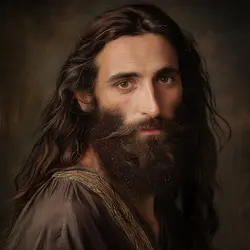Introduction
The following paragraphs show a rough idea of a 2nd proposed change in history, the 1st one being about physically/genetically equating cat and dog years with human years, going back thousands or a million or more years. To take a look at the 1st change, go to this article. The 2nd one here is about modern Judaism, going back as early as the 6th century, roughly between 500 and 599 CE.Simon of Rome (500-551 CE)
 The modern history of Judaism among Eastern Slavic peoples begins in the 6th century with the reforms from Simon of Rome. Simon was born January 1, 500 into a close-knit Jewish community in Rome. He grew up just as any normal Jew at that time would. However, Simon’s mother (483-514) died when he was 14, and his father (480-515) died when Simon was 15. He then opened to the outside world where things were much different.
The modern history of Judaism among Eastern Slavic peoples begins in the 6th century with the reforms from Simon of Rome. Simon was born January 1, 500 into a close-knit Jewish community in Rome. He grew up just as any normal Jew at that time would. However, Simon’s mother (483-514) died when he was 14, and his father (480-515) died when Simon was 15. He then opened to the outside world where things were much different.He learned to understand, read, write, and speak medieval Italian dialects fluently. What he found perplexing was that the people there considered their nationality as Roman and their faith as Christian. He had always identified himself as Jewish, not Roman, and did not even know the word “religion.” Over a period of trial and error, he concluded that his nationality was Roman and that his religion was Jewish.
Simon was known to have a photographic memory. He became ordained as a rabbi at age 20 and rose to become the head rabbi of his community by age 22. Outside his synagogue three years later, Simon announced to his congregation his four-fold reforms.
First, he would have his people come in contact with the outside world, where the Roman Italians were Christians.
Second, he would have his people assimilate into Roman Italian culture (i.e. adopting Latin names, Italian dress, and especially Roman nationality); thus, Simon adopted the Latin equivalent of his name, Semeonus.
Third, he would nullify certain Jewish laws, including numerous “commandments,” especially dietary laws. He believed that too many commandments were overabundant (And the commandments he would later emphasize would be reduced to the ten now known as the Ten Commandments). This reform permitted Jews to eat foods that were formerly forbidden to them due to old kosher “laws”, such as pork and shellfish. Simon believed that the dietary restrictions were not essential and considered them null and void. Also for the first time, they were allowed to eat meat with dairy products like cheese. Essentially, anything generally considered edible or “good eats” was now kosher.
Fourth, Simon proclaimed that it was the duty of the Jews to seek the conversion of as much Roman Italians as possible to Judaism. He reinterpreted the meaning of “God’s chosen people” to mean both that Jews were God’s treasured people, and that they were chosen to spread their morals through proselytizing. Although Simon’s reforms were far-reaching, he still had his people maintain core practices such as circumcision and observance of Jewish holidays.
Despite the apparent shock of these announcements, his congregation remained as connected to him as they were before Simon announced his reforms. They followed all that Simon said. After his successful attempts within one year to convert 2% of Italians in Rome to Judaism, the Pope issued a decree banning further Jewish missionary activity in order to keep Rome predominantly Christian.
Following this, Simon and his fellow Jews, including some Roman Italian converts, decided to move far away from Rome. They did this promptly, traveling progressively east until they reached what is now western Russia. There, they met Eastern Slavic peoples who welcomed them into their territory. In return for the Jews adopting Eastern Slavic culture, which included growing long beards at that time, 25% of all Eastern Slavs converted, within a period of ten years, from their native pagan religion to Judaism.
Simon settled and remained living near what is now Smolensk, Russia until he died of a blood infection, on August 28, 551, at the age of 51. Recent studies have shown that he probably had Asperger’s Syndrome, a slight form of autism.
Legacy of Simon
The massive number of Eastern Slavic converts to Judaism contributed to Eastern Slavic nations’ religious tolerance and their rich Jewish heritage that they have maintained to the present day, excluding the Soviet era. A few centuries later, when Vladimir, prince of Kiev, converted to Orthodox Christianity, he had most people living in Kievan Rus’ converted as well. While virtually all pagans converted to Christianity, only one fifth (5%) of Eastern Slavic Jews converted with them. The rest of the Jews remained with Judaism. This left the Eastern Slavs 75% Orthodox Christian, 20% Jewish, and 5% other faiths. After Vladimir’s death, many Eastern Slavic Jews became missionaries and subsequently gained many more Eastern Slavic converts to Judaism. The Mongols invaded and conquered Kievan Rus’ in the early 13th century. By that time, about 30% of all ethnic Russians, Ukrainians, and Belarusians were practicing Judaism (about 65% were practicing Orthodox Christianity), but the process of seeking converts came to a virtual halt. The Mongol Invasion had also cut off contact with the West until Ivan Petrov brought the Renaissance to Russia. (Ivan Petrov will be elaborated on in a future article.)
Prior to the coming of the Renaissance, Russians were unaware that Jews had been expelled from England in 1290. By 1400, the Renaissance had come into full swing throughout Europe and the Mongols had been ousted from Russia. The Russian discovery of Jewish expulsion from England and the spirit of the Renaissance prompted many of Russia’s Jewish missionaries to seek converts to Judaism throughout Europe. As a result, approximately 15% of gentiles in each European region or nation outside Russia, Ukraine, and Belarus converted to Judaism. The subsequent persecutions of converts to Judaism in England helped inspire even more English people to convert to Judaism, resulting in the policy of a virtual religious tolerance in England. Jews in exile were welcomed back. This policy of religious tolerance swept throughout Europe. However, Roman Catholic Church officials tried to intervene and frequently spent time devising tribunals against people accused of heresy, such as the Holy Inquisition in Italy, which didn’t affect Jews, as they were considered a completely different religious group. From the time Simon of Rome died in 551 to the early Renaissance, Jews throughout Europe, especially Russia, were granted titles of nobility.
To this day, most Jews in Western countries have been of ethnic European descent. For instance, most Jews in Russia are of ethnic Russian descent, and most Jews in Germany are of ethnic German descent. Also, virtually all European Jews have adopted secular names, such as Vladimir in Russia and Heinrich in Germany. Both are the legacy of the sought conversions to Judaism from Simon of Rome and his followers. However, two-thirds of Russian-American Jews belong to a group called Ashkenazim, while one-third do not belong to Ashkenazim and are of ethnic Russian descent.
Back in the late 1800s and early 1900s in Russia, non-Slavs, especially Ashkenazic Jews, who refused to adopt Russian given names and sometimes Russian surnames, in place of Jewish given names and Ashkenazic Jewish surnames, were subject to “Russification.” This was a nationalistic process instituted by the czars ensuring that citizens of the Russian Empire would accept the Russian language as their language and their nationality to be Russian as well. The czars forbade given names alien to them and insisted on those of Slavic origin. These policies were especially enforced upon Ashkenazic Jews, and if they refused to follow the policies, they were unofficially persecuted in pogroms.
The ancestors of American Jews of Ashkenazic-Russian descent fled Russia to the United States to escape these pogroms, while American Jews of ethnic Russian descent fled Russia to the United States because they considered Ashkenazic-Russian Jews who fled there to be linked to them like a spiritual family, a concept essential to all practicing Jews. Likewise, American Jews of Ashkenazic-Russian descent have an Ashkenazic Jewish heritage, while American Jews of ethnic Russian descent have a Russian heritage. Thus, both Russian Orthodox Christians and ethnic-Russian Jews share many characteristics.
Ethnic-Russian Jews have maintained virtually all Russian cuisine (with the exception of foods related to Christian holidays such as Christmas and Easter) of their gentile ancestors, but since the early Renaissance have absorbed the cuisine of Ashkenazic Jews migrating to Russia at that time. Before long Russia’s Orthodox Christians absorbed Ashkenazic cuisine as well. For instance, bagels and bialys have been a few of the common staples in a Russian breakfast, and knishes and potato and cheese blintzes have served as a Russian lunch for centuries. Fruit-filled blintzes, such as those filled with apples, cherries, or blueberries, have become common desserts in Russian cuisine.
[H2 id='Appeal+to+Judaism+in+Rest+of+Europe']Appeal to Judaism in Rest of Europe[/H2]
Prior to the entry of eastern Slavic Jewish missionaries from Russia, Ukraine, and Belarus into the rest of Europe, especially where the dominant religion was Roman Catholicism, Roman Catholics were not allowed to eat meat on Fridays throughout the entire year. The Jewish missionaries entered Roman Catholic Europe beginning around 1400.
Eastern Slavic Judaism appealed to many people in Roman Catholic Europe, partly because there were no dietary restrictions in this form of Judaism, with the exception of Passover, the Jewish holiday in which eating leavened bread was forbidden. (Also, this form of Judaism maintained holidays where fasting was mandatory.) As a result, early in 1407, to serve as a counter-revolution to the increasing popularity of Judaism in Europe, the Roman Catholic Church lifted the ban on eating meat on Fridays, with the exception of Lent, the only period throughout the year where the ban was maintained.
One result of the official 1407 proclamation would be as follows: Friday is considered a major pizza day for dinner, so since the late 1800s, with a mass wave of Italian immigration to the US, expect at least some Italian-American families in cities like New York to indulge in pizza with meat toppings on Fridays outside of the Lenten period, especially pepperoni, sausage, meatball, ham, prosciutto, salami, bacon, and/or pancetta.

